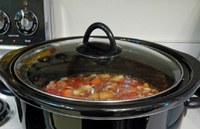Prairie Fare: Know Your Slow Cooker
(Click the image below to view a high-resolution image that can be downloaded)
By Julie Garden-Robinson, Food and Nutrition Specialist
NDSU Extension Service
Do you remember the marketing phrase, “cooks all day while the cook’s away?” That was the slogan for Rival Crockpot, the original slow cooker, in the early 1970s.
At that time, women were joining the workforce in large numbers, and this new kitchen appliance was presented as a solution to meal preparation for busy families.
Through the years, various manufacturers have offered slow cookers in various sizes, shapes and colors. Slow cookers offer the opportunity to come home to the aroma of a home-cooked meal.
Being a working mother, I’m a big fan of slow cookers. I have a collection of them, actually.
For our wedding back in 1993, my husband and I received thoughtful and useful gifts. Among the gifts were three slow cookers. This brought the total number of slow cookers in our now combined household to six.
My husband had one large and one small slow cooker with glass covers in a burnt umber (brownish) shade characteristic of the mid-1970s. I had a cream-colored slow cooker with country-blue flowers and a plastic cover from the mid-1980s.
Our old slow cookers weren’t exactly stylish kitchen accessories in the 1990s, but they served their purpose. We weren’t planning to open a catering business, so we exchanged the three new slow cookers for some other items we didn’t have.
Today, our original slow cookers still work, but I decided to update my appliances to add a sleek stainless steel slow cooker last year. It has three settings. When we prepared our first dish in the slow cooker, we discovered it heated at a much higher level. My husband used the word “incinerated.” Our old slow cookers didn’t boil the food.
Had I purchased a nuclear-powered slow cooker? Was it really a microwave oven? We decided that the manufacturers probably have “souped up” the power on the slow cookers because people prepare all sorts of foods in them.
I continue to use the old “built-to-last” slow cookers in our pantry. I use the hot slow cooker for quick turnaround meals.
The U.S. Department of Agriculture recently updated its slow cooker tips, which are summarized below. You will find more tips, including how to adjust regular recipes for preparation in a slow cooker, in our newly updated “Now Cooking: Slow Cooker Meals” publication available at http://www.ag.ndsu.edu/pubs/yf/foods/fn1511.pdf.
If you use a slow cooker, are these statements true of what you do?
- Wash your hands before, during and after food preparation.
- Always start with a clean slow cooker, utensils and work surface.
- Always thaw meat and poultry in the refrigerator before cooking in the slow cooker. This will ensure complete cooking.
- Consult the instructions that came with your slow cooker for recommendations on large cuts of meat and poultry. Slow cookers are available in different sizes, so the instructions will vary. If you cannot find the instructions, you can cut the meat into smaller chunks to ensure thorough, safe cooking. Add the liquid, such as broth, water or barbecue sauce, suggested in the recipe and keep the lid in place during cooking.
- Refrigerate these perishable foods in separate containers until you are ready to use them if you cut up meats or vegetables ahead of cooking.
- Place the vegetables in the slow cooker first because vegetables cook slower than meat and poultry. Place the meat on top of the vegetables and top with liquid, such as broth, water or
a sauce.
- Spray the inside of the cooker with nonstick cooking spray before using it for easy cleanup and care of your slow cooker. Slow cooker liners also ease cleanup.
- Fill the slow cooker no less than half full and no more than two-thirds full. Cooking too little or too much food in the slow cooker can affect cooking time, quality and/or safety (if filled too full).
- Set your slow cooker on high for the first hour if possible, then turn the heat setting to low to finish cooking. Keep the lid in place. Removing the lid slows cooking time.
Try this flavorful recipe paired with corn muffins, fresh fruit and milk for a balanced meal.
Slow Cooker Mexican Beef Stew
1 c. carrots, cubed
2 c. potatoes, peeled and cubed
1 c. onion, quartered
1 1/2 pounds beef stewing meat, cubed
1 (8-ounce) can tomato sauce
1 package dry taco seasoning mix
2 c. water, divided
1 1/2 Tbsp. cornstarch
1/4 tsp. pepper
Layer the first four ingredients in the slow cooker. Add tomato sauce. Combine the taco seasoning with 1 1/2 cups of water. Stir cornstarch into the remaining 1/2 cup of water until smooth. Stir into water with taco seasoning. Pour over ingredients in slow cooker. Sprinkle with salt and pepper. Cover. Cook on low for seven to eight hours or on high for three to four hours. Serve over rice or noodles if desired.
Makes eight servings. Each serving has 210 calories, 6 grams (g) of fat, 19 g of protein, 17 g of carbohydrate, 2 g of fiber and 330 milligrams of sodium.
(Julie Garden-Robinson, Ph.D., R.D., L.R.D., is a North Dakota State University Extension Service food and nutrition specialist and professor in the Department of Health, Nutrition and Exercise Sciences.)
NDSU Agriculture Communication – Nov. 7, 2013
| Source: | Julie Garden-Robinson, (701) 231-7187, julie.garden-robinson@ndsu.edu |
|---|---|
| Editor: | Rich Mattern, (701) 231-6136, richard.mattern@ndsu.edu |


